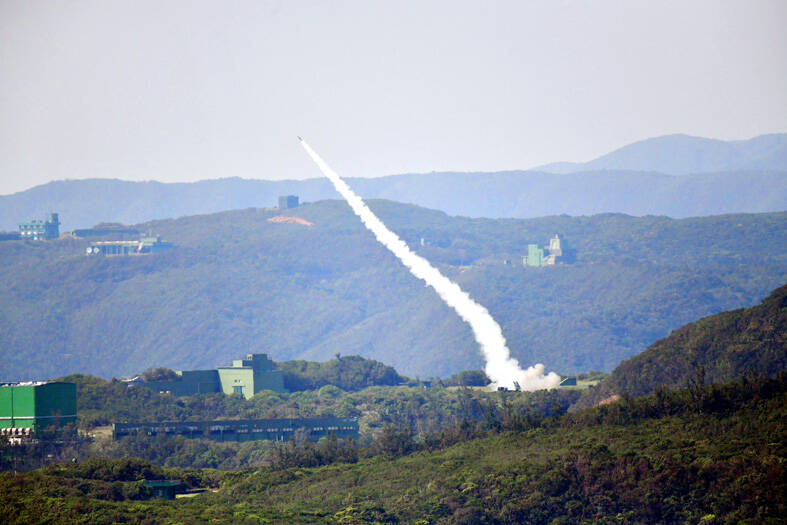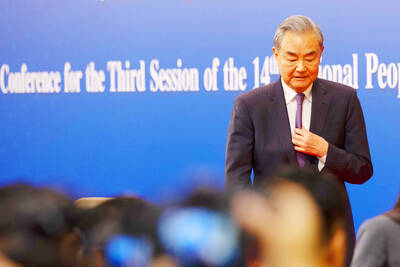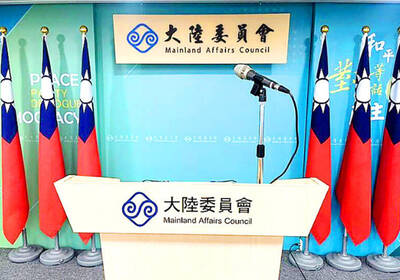Domestically developed Land Sword II (陸射劍二) missiles were successfully launched and hit target drones during a live-fire exercise at the Jiupeng Military Base in Pingtung County yesterday.
The missiles, developed by the Chungshan Institute of Science and Technology (CSIST), were originally scheduled to launch on Tuesday last week, after the Tomb Sweeping Day holiday long weekend, but were postponed to yesterday due to weather conditions.
Local residents and military enthusiasts gathered outside the base to watch the missile tests, with the first one launching at 9:10am.

Photo: Tsai Tsung-hsien, Taipei Times
The Land Sword II system, which is derived from the Sky Sword II (天劍二) series, was turned over to the army in May last year to replace its MIM-72A/M48 Chaparral surface-to-air missile system.
Three missiles were launched during the live-fire training.
A Ministry of National Defense report submitted to the Legislative Yuan last month showed that the army has leased target drones from the institute.
Starting this year, the Land Sword II missiles would be test-fired once each year, including the firing of three missiles and one target pursuit, the report said.
The Sky Sword system consists of an engagement control vehicle, a CSIST-developed Bee Eye radar system, a launch vehicle and an ammunition carrier, with an effective range of up to 15km, it said.
With the system, the vehicle crew can perform a 360o search, tracking and monitoring within the detection range, it said.
The system can detect enemy fixed-wing aircraft, rotary-wing aircraft, uncrewed vehicles and cruise missiles, and it can also be integrated with active Avenger missiles and twin-mounted Stinger missiles to bolster regional air defense capabilities, it said.
In other news, 11 Chinese People’s Liberation Army (PLA) aircraft crossed the median line of the Taiwan Strait or its extension in the 24-hour period starting at 6am on Sunday, the Ministry of National Defense said yesterday.
Eight of the aircraft crossed the median line, while three crossed the extension and entered Taiwan’s southwestern air defense identification zone (ADIZ).
Both groups consisted of an unspecified number of fighter jets and drones, flight paths and information released by the ministry showed.
Some of the aircraft flew as close as 41 nautical miles (76km) from the northern city of Keelung, the information showed.
In total, 18 PLA aircraft were detected in Taiwan’s ADIZ during the same period, while six PLA Navy vessels were also found to be operating in waters around the country, the defense ministry said.
The ministry said it deployed combat air patrol aircraft, navy vessels and coastal missile defense systems in response.
The ministry has stopped its practice of identifying the types of PLA aircraft detected in Taiwan’s ADIZ since Jan. 16.
Considering the changing security situation and threats, identifying the types of PLA aircraft could play into the hands of China, which could exploit this information to wage cognitive warfare campaigns against the Taiwanese public, military spokesman Major General Sun Li-fang (孫立方) said at the time.

‘DANGEROUS GAME’: Legislative Yuan budget cuts have already become a point of discussion for Democrats and Republicans in Washington, Elbridge Colby said Taiwan’s fall to China “would be a disaster for American interests” and Taipei must raise defense spending to deter Beijing, US President Donald Trump’s pick to lead Pentagon policy, Elbridge Colby, said on Tuesday during his US Senate confirmation hearing. The nominee for US undersecretary of defense for policy told the Armed Services Committee that Washington needs to motivate Taiwan to avoid a conflict with China and that he is “profoundly disturbed” about its perceived reluctance to raise defense spending closer to 10 percent of GDP. Colby, a China hawk who also served in the Pentagon in Trump’s first team,

SEPARATE: The MAC rebutted Beijing’s claim that Taiwan is China’s province, asserting that UN Resolution 2758 neither mentions Taiwan nor grants the PRC authority over it The “status quo” of democratic Taiwan and autocratic China not belonging to each other has long been recognized by the international community, the Mainland Affairs Council (MAC) said yesterday in its rebuttal of Beijing’s claim that Taiwan can only be represented in the UN as “Taiwan, Province of China.” Chinese Minister of Foreign Affairs Wang Yi (王毅) yesterday at a news conference of the third session at the 14th National People’s Congress said that Taiwan can only be referred to as “Taiwan, Province of China” at the UN. Taiwan is an inseparable part of Chinese territory, which is not only history but

CROSSED A LINE: While entertainers working in China have made pro-China statements before, this time it seriously affected the nation’s security and interests, a source said The Mainland Affairs Council (MAC) late on Saturday night condemned the comments of Taiwanese entertainers who reposted Chinese statements denigrating Taiwan’s sovereignty. The nation’s cross-strait affairs authority issued the statement after several Taiwanese entertainers, including Patty Hou (侯佩岑), Ouyang Nana (歐陽娜娜) and Michelle Chen (陳妍希), on Friday and Saturday shared on their respective Sina Weibo (微博) accounts a post by state broadcaster China Central Television. The post showed an image of a map of Taiwan along with the five stars of the Chinese flag, and the message: “Taiwan is never a country. It never was and never will be.” The post followed remarks

INVESTMENT WATCH: The US activity would not affect the firm’s investment in Taiwan, where 11 production lines would likely be completed this year, C.C. Wei said Investments by Taiwan Semiconductor Manufacturing Co (TSMC, 台積電) in the US should not be a cause for concern, but rather seen as the moment that the company and Taiwan stepped into the global spotlight, President William Lai (賴清德) told a news conference at the Presidential Office in Taipei yesterday alongside TSMC chairman and chief executive officer C.C. Wei (魏哲家). Wei and US President Donald Trump in Washington on Monday announced plans to invest US$100 billion in the US to build three advanced foundries, two packaging plants, and a research and development center, after Trump threatened to slap tariffs on chips made